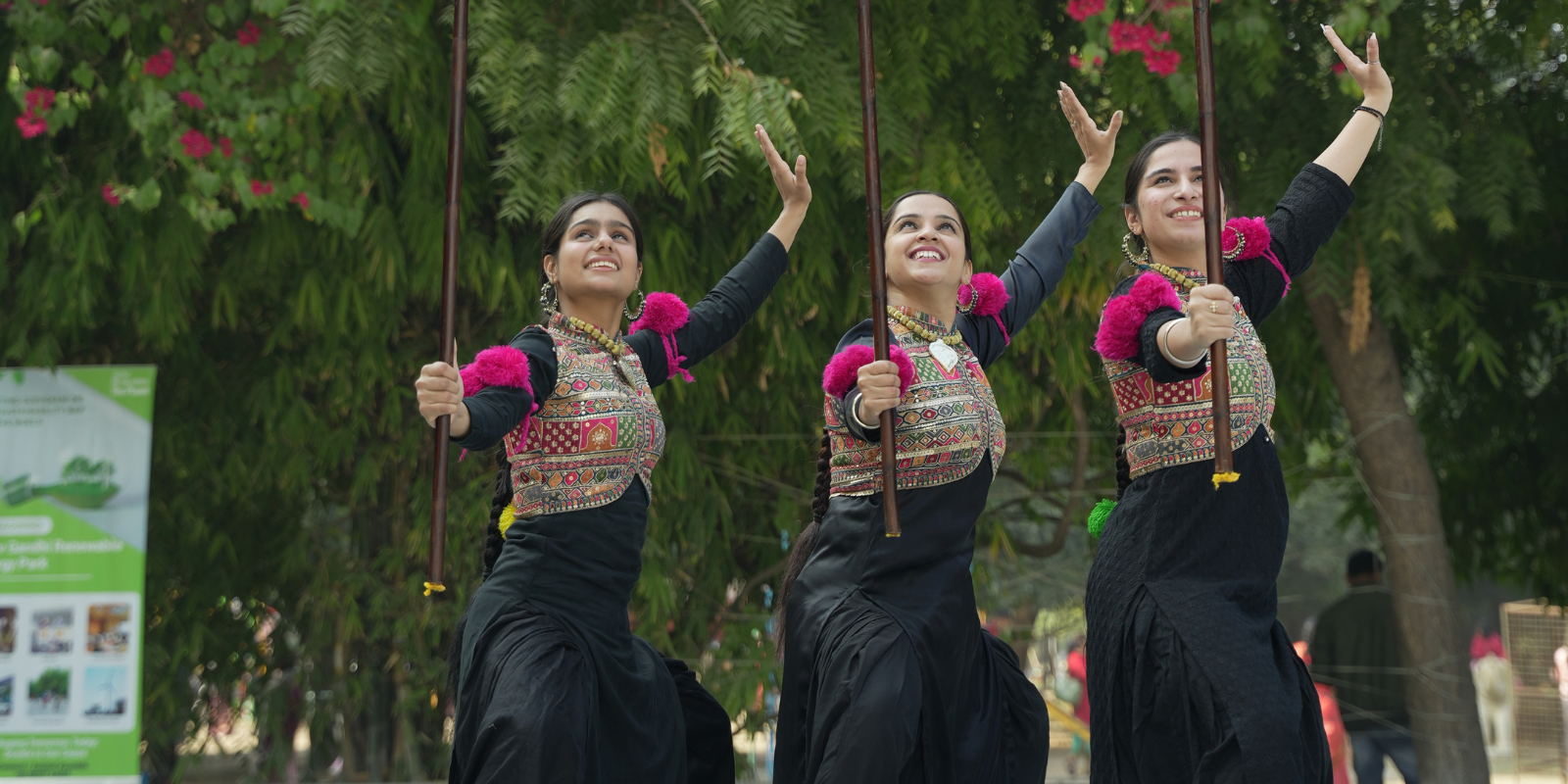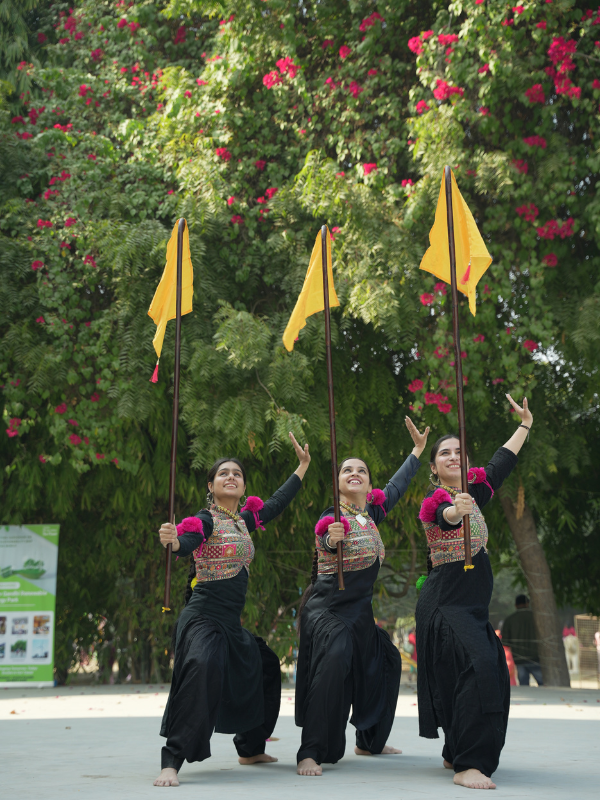

Nazm Kaur 22 Aug, 2024
This is a story about a young woman’s quest for identity and fulfilment. It’s also a tale of a dancer’s battle for recognition, for her and her fellow queens.
Once, when I was one-and-a-half years old, in the interval during a cultural event, I told my mother I wanted to go onto the stage. Everybody was shocked, asking what would such a young child perform? But so stubborn was I that Ma relented, wrapped her chunni around me to make it look like a sari, and put me up on stage.
My first experience with dance was with Kalbelia, a Rajasthani folk dance, when I was in pre-nursery. I was taking part in a dance competition, in which I stood first, and received a lot of appreciation. So, folk dance became my childhood dance journey, gave me recognition, and always allowed me to stand out.
But my journey in Bhangra began after Covid, in 2021. Before the pandemic, I felt lost because I was trying to find my space in different dance styles. I was following the trends in reality shows. Then I wanted to get into musicals, and become an actor who can dance. Then I started doing Western-style dance, and I started teaching also. I wanted to become an all-rounder, but in the race to becoming one, you become jack of all but master of none. Besides, I was not enjoying what I was doing.
Success started early for me but when you face rejection as you grow up, you start doubting yourself. You begin thinking, ‘Where did I go wrong?’ Because, from a very young age, I was coming first in every competition I entered—why, then, am I getting rejected now? Because what I was performing during my childhood was unique. It was something no one else was performing. Yet, I didn’t realise that as I grew older, and continued to do what I was doing, many others were also doing the same thing. It was no longer unique.
Then my instructor and very old friend, Tarun, from the Terence Lewis Dance Academy, Mumbai (from where I got a dance diploma), asked me, ‘What exactly do you want to do?’ I replied, ‘I want to do only dance, but what should I do that is unique?’ He asked, ‘What do you like?’ I responded, ‘What I like is folk but that is now out of fashion.’ He said, ‘Okay, then do folk! No one in India is doing folk, so bring it back, and shine a light on it.’ After that, there was no going back.
What’s more, I really wanted to do something empowering for girls. I thought that if I can face these problems, then so many girls would be facing the same too. So, as a way of contributing to my community as an artiste—doing seva, or service, which is a big part of the Sikh faith—I started Bhangra Queens. I started with five girls and today we’re about 20. Initially, we would meet to practice, by watching Bhangra videos on YouTube, and just doing something together. The ‘Queens’ comes from my last name, Kaur (princess in Punjabi), and it reflected my wish that every girl who wants to become a part of the group should become a Queen. Bhangra Queens helped me get my strength back, and took me back to where I started. It also gave me an identity, and enabled me to live out my life’s purpose.
We did not perform Bhangra the way girls should do it, but as it is. Only, the gender of the performers is different. We did not play with the steps, or the songs, or the costumes. All we did was bring a feminine energy to this vibrant folk dance, without disturbing its authenticity. I think that’s what has made us more acceptable to the traditionalists. Also, we really invested in our training, thinking about how we should look, and what we should wear, when we perform. Moreover, we are always invited to open an event, or do the finale, because Bhangra is a dance that touches that high point of happiness.
Bhangra is not seasonal; it is embraced all year round. It’s popular globally because of the singers, who are known across the world. The language is appealing, as is the music. It’s also a mood lifter, whether it’s performed in a wedding or on a cultural night, whether it’s played in a gym session or during a dance class. When you hear the Bhangra beat, your shoulders move automatically. And it does not require a specific way of communication, because the music, the costumes, the vibe and the energy speak for it.
Yet, it’s important to remember that this dance form is not easy; it requires so much physical strength and stamina, and so much practice. So, whenever we practice or perform Bhangra, it makes us feel even bolder. Also, there are very few dance styles that are embraced by the person who is watching you. And that brings me back to my purpose of seva: as an artiste, if you are coming to watch me, I make sure that you return home happy.
What I have always been fighting for, and working hard for, is recognition. And the struggle to get recognition continues, because the least we artistes should fight for is recognition. I remember Satinder Sartaj’s gesture during a live concert. He was sitting in the centre and we were performing to his left and right. He was singing but stopped in the middle of a song, to ask all of us our names and the name of our group. He then announced our names to the audience and requested everyone to give Bhangra Queens a standing ovation.
I see so many Nazms in my fellow Queens. When they look up to me as a role model, it reminds me to keep training and grooming myself, to keep practicing and getting better. That’s the reason I choose to perform every time, and not just sit on the side as a choreographer. Performing with them and also teaching them gives me a sense of equality.
When we’re on stage, we are all Queens. Our focus is on what we’re doing, on our passion. I don’t know what happens in those three minutes of performing; nothing else enters our minds. In fact, we don’t even realise that those three minutes are over. Because, there’s only the stage, the lights and the audience—we’re not thinking of anything else. And that’s the magic. Every time we go back onto the stage, it’s always so healing.
Dancer, choreographer and inspiration behind Gurgaon-based Bhangra Queens, Nazm Kaur will be performing at the Edinburgh Art Festival in August. She has a double PG degree in English and Kathak, and is a SPIC MACAY scholarship student in art education. Nazm has performed across the world, and her group recently collaborated with Diljit Dosanjh. You can follow Bhangra Queens on YouTube (@bhangraqueens) and Instagram (@bhangra.queens)